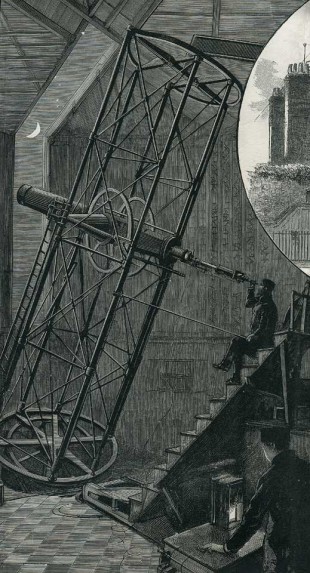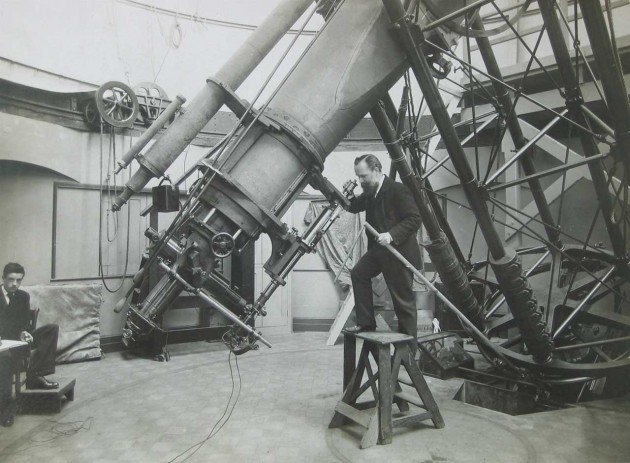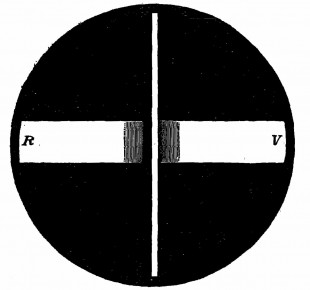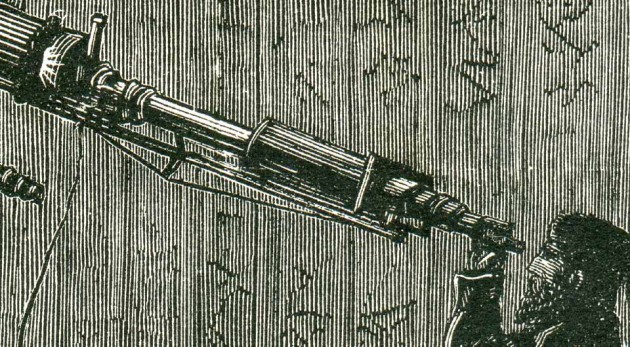…where east meets west
- Home
- Brief History
- The Greenwich Meridian
- Greenwich
(1675–1958) - Herstmonceux
(1948–1990) - Cambridge
(1990–1998) - Outstations (1822–1971)…
- – Chingford (1822–1924)
- – Deal
(1864–1927) - – Abinger
(1923–1957) - – Bristol & Bradford on Avon
(1939–1948) - – Bath
(1939–1949) - – Hartland
(1955–1967) - – Cape of Good Hope
(1959–1971)
- Administration…
- – Funding
- – Governance
- – Inventories
- – Pay
- – Regulations
- – Royal Warrants
- Contemporary Accounts
- People
- Publications
- Science
- Technology
- Telescopes
- Chronometers
- Clocks & Time
- Board of Longitude
- Libraries & Archives
- Visit
- Search
Spectroscopes: Christie’s direct-vision ‘half-prism’ spectroscope (1877)

The half-prism spectroscope in use on the 12.8-inch Merz Refractor. From the 8 August 1885 edition of The Graphic. The image was accompanied by a description from which the following extract is taken: 'The assistant at the table is pressing a touch-piece which completes the circuit between the battery on his left and the induction coil, and by so doing causes the electric spark to pass though a glass tube near the front of the spectroscope. The observer at the instrument has thus the spectrum of hydrogen and that of the star before him, and is able to measure the distance between a hydrogen line in the spectrum from the glass tube, or, as it is termed, "the displacement of the line in the star spectrum."'
The ‘half-prism’ spectroscope was mounted on the 12.8-inch Merz Refractor in July 1877. The Merz, however, proved too small to allow anything but the brightest stars to be observed. The Lassell Telescope which was acquired in 1883 was more powerful, but was unsuitable for spectrographic work as its mounting and clock-work were not capable of carrying a heavy spectroscope. Christie therefore set about trying to procure a larger refractor. In 1885, he secured agreement from the Admiralty to provide the funding to allow him to replace the Merz with a larger 28-inch refractor on the same mounting, the justification being that it was needed to allow the spectrographic work to proceed effectively. The spectroscope was dismounted from the Merz in 1891 when the telescope itself was dismounted. After some delay, the new telescope eventually became operational at the start of 1894, with the spectroscope being mounted that June. Later that year, a regular programme of double star observations commenced together with a limited programme of spectrographic work. The latter was abandoned in November 1895 supposedly so that Maunder could concentrate on the heliographic reductions. The real reason is more likely to have been that in the years between the telescope being ordered and finally delivered, it had become apparent that the way forward with this work would involve not visual line-of-sight spectroscopic measurements, but photographic ones.
When it was mounted on the 12.8-inch refractor, light passed directly from the telescope into the spectroscope. Because of the much greater physical length of the 28-inch-refractor, such a mounting was not possible. The light path was therefore bent though 180º using first a mirror and then a prism and the spectroscope mounted below the telescope tube with its axis parallel to it.

The 28-inch refractor with E Walter Maunder at the half-prism spectroscope. His assistant is William Bower, a computer, who became established in 1896. Photograph by David Edney, c.1895. Reproduced by permission of the Greenwich Heritage Centre (see below)
The disparaging comments of William and Margaret Huggins
In her book Unravelling Starlight (p.312) Barbara Becker quotes, Margaret Huggins (wife of William Huggins, the great pioneer of Spectroscopy) who was quite disparaging of the instrument. In 1911, following her husband’s death, she worte:

F line in the spectrum of Sirius as compared with Hβ line of Hydrogen, December 1875. From Maunder: The motions of stars in the line of sight, The Observatory, Vol. 8, p. 117-122 (1885)
That detestable Half-Prism spectroscope which Mr. Christie (as he then was) designed & would not give up, – we considered brought discredit on poor Mr. Maunder, – & in some eyes on the Line-of-Sight Method itself. Why – there were nights when the same star – both approached & receded. Danced in fact most flighty – shamelessly flighty – manner!
I was miserable over it; & Sir William [Huggins] felt it so much that he really implored Mr Christie to change the Spectroscope. But – no! nothing would move him. So the laughter went on at Potsdam & elsewhere – They were moved!’
Christie’s description of the spectroscope
A description of the spectroscope was published in the introduction to each of the volumes of Greenwich Observations from 1877 until 1900. The written description changes slightly from one year to the next in the early years until 1883 when it became consistent from one year to the next. The description below is extracted from the 1897 volume. Click here to read it as originally published.
‘The direct-vision “half-prism” spectroscope, constructed by Mr. Hilger, has been used from 1877 July to 1891 November in connection with the 12.8-inch Merz refractor mounted on the Great Equatorial. In this form of spectroscope, either great dispersion or great purity of spectrum is obtained by the use of “half-prisms,” * according as the incident pencil falls first on the perpendicular or on the oblique face. Either one, two, or three “half-prisms” can be used at pleasure, according to the dispersion required, and each “half-prism” is compound, being composed of a flint “half-prism” and a crown prism cemented on the oblique face so as to form the half of a direct-vision prism, as cut by a plane perpendicular to the base. With one “half-prism” a dispersal of about 18½º from A to H, equivalent to that given by four flint prisms of 60º, is obtained, with two “half-prisms” a dispersion of about 80º from A to H, equivalent to that given by sixteen flint prisms of 60º, with three “half-prisms” a dispersion of about 300º, equivalent to that given by about sixty flint prisms of 60º, the pencil in each case being incident on the perpendicular face of each “half-prism” and emerging at the oblique face. For observations of the Solar prominences, where great purity of spectrum is desired, the slit and eyepiece are interchanged, so that the pencil is incident on the oblique face and emerges at the perpendicular face of each prism. The cross-section of the first prism is 2 inches in height by 2 inches in breadth, of the second prism 2 inches in height by 0.6 inch in breadth, and of the third prism 1 inch in height by 0.4 inch in breadth, the pencil being made narrower by the oblique emergence at each prism. The collimator and viewing telescopes have focal lengths of about 23.2 and 11.6 inches respectively with apertures of 2¼ inches. Different parts of the spectrum are brought into the field by turning the “halfprisms,” each through the same angle, about fixed centres, by means of a micrometer-screw acting on a lever. For delicate measures a micrometer eyepiece is used.
The spectroscope was mounted on the 28-inch refractor in 1894 June. It is planted with its axis parallel to the tube and below it (in the position for objects south of the zenith), the rays being thrown into the collimator by two reflexions, first from the mirror for diagonal view in the telescope tube, placed about 26 inches within the focus, and then from a small rectangular prism close to the slit and 24 inches from the axis of the refractor, mounted in an adapter carried by the sliding eye-end. The spectroscope is firmly attached to the telescope tube by strong castings with suitable collars, having sliding adjustment for focus, and allowing of rotation of the spectroscope for orientation of the slit parallel or perpendicular to the equator. By this arrangement the spectroscope is permanently mounted on the refractor, the mirror in the tube being inserted for spectroscopic observations and withdrawn for eye-observations.
Occasionally for faint objects another spectroscope of smaller dispersive power is used. This spectroscope has a. single prism of flint glass, with a collimator of about 20 inches focal length and a viewing telescope of about 10 inches.
Ample provision is made of the necessary auxiliary apparatus; namely, a Sprengel air-pump, with Crookes’ improvements, made by Hicks; an induction-coil, by Browning; and a battery, by Ladd.
* A “half-prism” is that half of an isosceles prism cut by a plane perpendicular to the base, so that the rays fall perpendicularly on the face so formed. The general theory of this form of spectroscope is give in the Proceedings of the Royal Society, vol xxvi. p.8.’
The fate of the spectroscope
The fate of the spectroscope is undocumented. The introduction to the 1900 volume of Greenwich Observations is the last published reference to it still being on the 28-inch refractor. It does not appear to be listed in the 1911 inventory (RGO39/4). Recorded in the 1926 inventory (RGO39/05/103) as being in the South Building (Lower Museum, Case H), its current whereabouts is unknown. The inventory does however record that the eye-end for adapting the spectroscope to the telescope together ‘various accessories’ were condemned (and presumably disposed of) in January 1930.
Published observations
The results obtained with the Spectroscope were published each year in the annual volumes of Greenwich Observations. Links to the relevant sections are given below. The results were also published in the Monthly Notices of the Royal Astronomical Society. No results were published for the years when it was used on the 28-inch refractor.
| 1877 | 1878 | 1879 | 1880 | ||
| 1881 | 1882 | 1883 | 1884 | 1885 | |
| 1886 | 1887 | 1888 | 1889 | 1890 | |
| 1891 |
Further reading
The motions of stars in the line of sight, Maunder, E. W. The Observatory, Vol. 8, p. 117–122 (1885)
The motions of stars in the line of sight, Maunder, E. W. The Observatory, Vol. 8, p. 162–170 (1885)
Unravelling Starlight, Barbara J Becker, Cambridge, 2011
Acknowledgements
Special thanks are due to the Greenwich Heritage Centre for permission to reproduce the photograph of E Walter Maunder with the half-prism spectroscope on the 28-inch refractor.
© 2014 – 2025 Graham Dolan
Except where indicated, all text and images are the copyright of Graham Dolan
